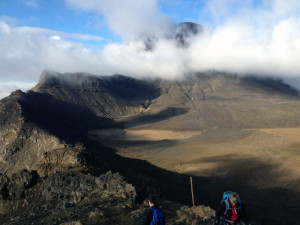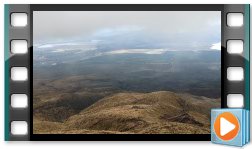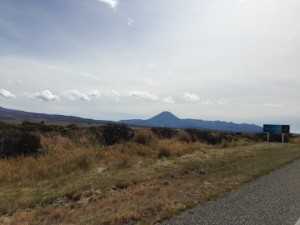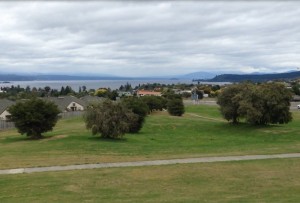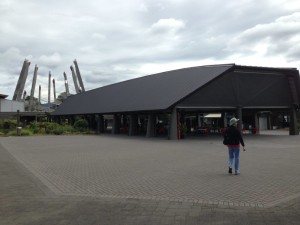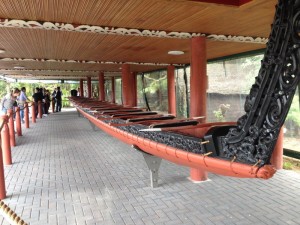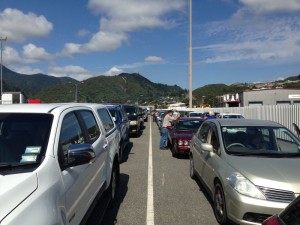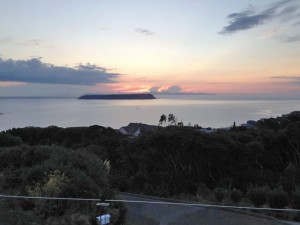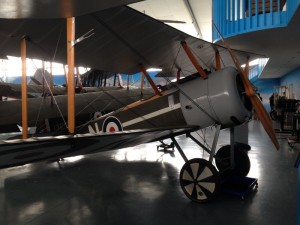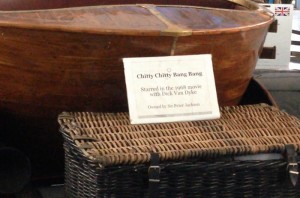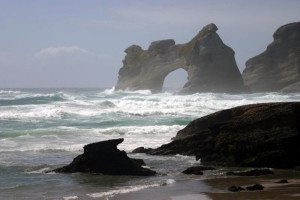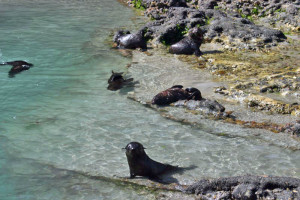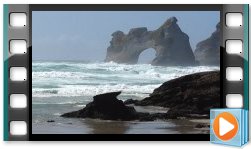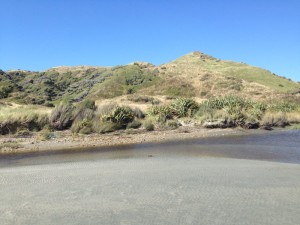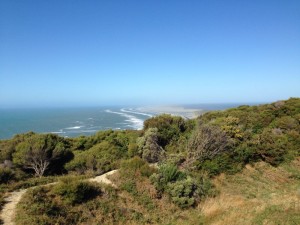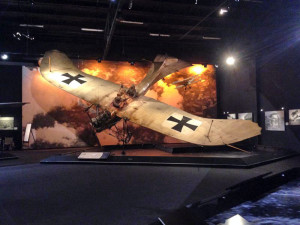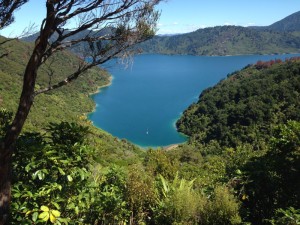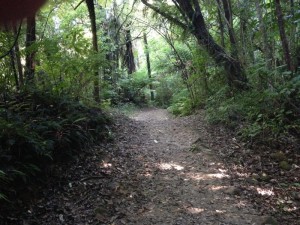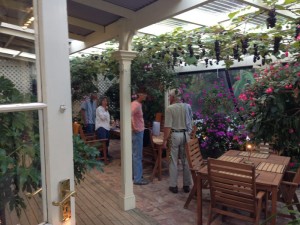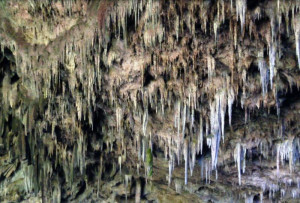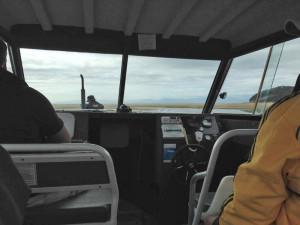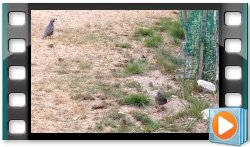 Mount Ruapehu. If you look in the middle left of this picture you will see the Whakapa Ski area. This mountain was used for close up shots of Mount Doom in the “Lord of the Rings” movies.
Mount Ruapehu. If you look in the middle left of this picture you will see the Whakapa Ski area. This mountain was used for close up shots of Mount Doom in the “Lord of the Rings” movies.
Zoomed in you can easily see the ski resort on the side of mount doom.
Mount Ngauruhoe is the volcano used for the distance shots of Mount Doom in the “Lord of the Rings” movies.
Mount Tongariro. As Barb said it erupted two years ago and is still belching steam and gas.
So after checking in at our little cottage, we drove to do a short hike up to a lake and then on the way back, decided to drive up toward Ruapehu, to check out the Whakapa Ski Field. Strangely, as you drive up through the lower flats, you come to a little village. In that village is the park visitor center and Chateau Tongariro. Now this 1929 hotel looks very much like the big Chateau hotels in Canada, that were built when the east/west rail was built. We’ve visited one in Quebec City with the girls, and one on Vancouver Island, where we had our one and only high tea. This one here also offers high tea – at the base of three active volcanoes! Apparently, it was styled after the Chateau hotel in Lake Louise. You then start climbing up this twisty, turny road through aptly named Scoria Flats. This was the most bizarre ski area I had ever seen. There was little to no plant life – just volcanic rubble everywhere. It looked like we had arrived at Mordor and it was hard to imagine that they could get enough snow to cover all that rock. There were two men talking in the parking lot and it looked like they worked there, so I asked them how much snow they needed to actually make this rockfest skiable. I think we were actually talking to two senior managers there – I know one guy ran all of the ski school, rentals, food, etc. and I think the other was the general manager. Anyway, they spent a half hour talking about the ski area. It is surrounded by about 20 big houses – ski clubs apparently that can house up to about 1,000 people – not unlike Norwalk ski club. He said that sleeping in club dorms is going out of style so they aren’t used as much. They get up to 5,000 people on a good day and their sister area around the backside can get an equal number. They have one very small parking lot, so I have no idea where people park. They said it was like Mammoth skiing – they are 90 km from the ocean and get big wet dumps. They often have to move snow around, as it fills in pockets and must be moved onto the groomed slopes. All very 60’ish. No sign of high speed quads, escalators to the lodge, or warm freshly baked cookies. Just old fashioned skiing.
 Chateau Tongariro on your way up to the ski area. I wish we had gone inside but did not have time.
Chateau Tongariro on your way up to the ski area. I wish we had gone inside but did not have time.
Just coming up on the ski area. It was a cold, windy, drizzly day and the mountain was in a cloud.
The main ski village. The building on the left is the ski rental and school and the building on the right is where you buy your lift tickets.
Below on the left is the beginner area. The manager said that they have a “magic carpet” down there for the little kids.
This is the only lift we saw that would take you up into the ski fields. Look at all the rocks. You would think that a lot of snow would have to fall to cover those rocks. You can also see why the close up shot of Mount Doom were filmed in this area.
This video will give you a good idea of the feel of the ski area.
The next morning we got up and got on a shuttle at our lodge at 6 a.m. to get taken to the start of the Alpine Crossing. This track is reputed to be the best day hike in NZ and gets tons of traffic. It was still pitch black when we got there, so we sat at the start and ate our breakfast burritos till it got light enough to walk. This walk goes up between Tongariro and Ngauruhoe, before looping around the other side of Tongariro and back down the north side. At the start of the track was effectively a set of traffic lights. If the green light was on, walk on. If the red light was on, get out of there fast. There were two other sets of these, one at the top of the Red Crater and one as you head down to the DOC hut. Heaven help you if you’re all the way up there and you spot a red light! The hike itself was like walking through Mordor. My friends at the Rock Garden Society would have enjoyed all of the little buns at the early part of the walk but then it headed up, up, up what is called the Devil’s Staircase. We walked across two absolutely flat, plant-less craters. It felt like walking on the moon. We were supposed to be able to see down to Red Crater, but on top we were in the middle of a windy, cold cloud. It was in the 20’s up there with the wind chill. We walked across this narrow ridge of loose, dirt-like scoria, by some emerald green lakes, and then between the hut and the steaming crater. All very surreal and beautiful in a weird way. And a bit Crawling Eye-ish up top on the ridge. We were never alone – there was a constant stream of people on this track, some dressed for summer but at least we saw no flip-flops. It was about 19.5 km long – our longest hike to date and one of the most interesting. Too bad to miss the view of Red Crater and Blue Lake, but still really cool. We then got picked up by the lodge shuttle and headed back for a well deserved nap.
 We got an early start about 6:30 am we began the hike. I used my headlamp for about a 1/2 hour until it was light enough to see without it.
We got an early start about 6:30 am we began the hike. I used my headlamp for about a 1/2 hour until it was light enough to see without it.
This electronic sign is just to the left of the trail sign shown above. Please note that the light is green. We may be crazy, but not stupid. 🙂
We had just started the hike and working our way up towards the volcanoes. If you look closely in the center, you will see the crescent moon.
After a short distance in the dark and on a gravel trail the track became a boardwalk. We are working our way up to the valley where the only way out is up.
The hike up, out of the valley is known as the “Devils Staircase”. This is on the staircase looking back down into the valley where we had just come.
Barb getting close to the top of the staircase.
At the top of the “Devils Staircase” you come out onto an ancient caldera. It is totally flat and must have been a half a kilometer across. Very strange.
Mount Ngauruhoe from the caldera.
After crossing the caldera we climbed up to the highest point of the hike and had lunch. Mount Ngauruhoe is in the cloud behind Barb and you can see the flat caldera below.
We had had a snack up here at the highest point of the hike and there was another electronic sign. Please note it is NOT red! Whew. If it were I’m not sure I would know which way to run. 🙂
Looking past the sign to where we were heading. This part of the hike is right along the craters rim. To the right is Red Crater, to the left the side of the volcano’s cone.
It was VERY cold and windy. Occasionally we would get a bit of warm, stinky air blow by so we knew we were close to the action, we just couldn’t see it.
I swiped this picture from the internet. This is what we should have seen, Red Crater.
This is what we saw of Red Crater. 🙁 However I don’t know, the cloud gave everything such an eery, surreal feeling. It was very cool in its own way.
The larger of the two emerald lakes below Red Crater.
After descending the Red Crater cone we came out onto another ancient caldera . Dead flat.
On the descent we had a large steam vent on our left. This is looking back up at the vent. You can see the track in the bottom of the picture.
To our right was Mount Tongariro, which had erupted a couple of years ago.
A panorama video of our descent. You can see the DOC hut that was damaged when Mount Tongariro erupted.
I swiped this image from the internet too. This is the track we took by Red Crater and the two emerald lakes. At the very top of the picture is where we had stopped for our snack.
This sign sort of says it all. 🙂 Without question this was the most memorable hike I’ve ever done. It was like being on another planet.
















